Distinguished Critique: JLA/JSA: Virtue and Vice Review
Some odd storytelling decisions aside, this one-shot presents a holiday-tinted tale brimming with strong characters from two generations of heroes
—by Nathan on November 27, 2025—
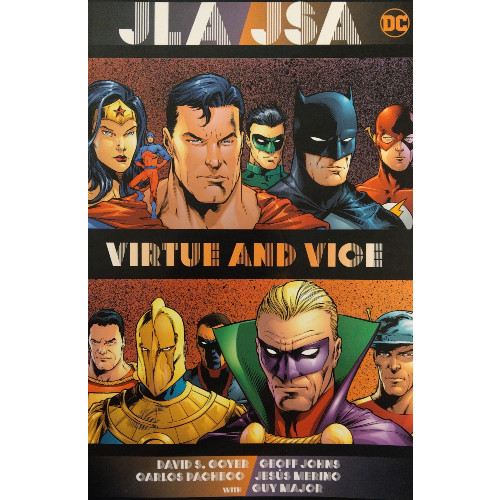
Today marks one of my favorite holidays out of the entire year, certainly my second favorite outside of Christmas. I discussed, in my Batman: Haunted Knight review, my personal love for the Thanksgiving season, found in fun, family, food, and festivities. Even as a grown man, I still get a kick out of the annual Macy's Thanksgiving Day Parade, and despite my picky, particular appetite, I find I enjoy several offerings featured at our bountiful dinner table.
Where I am less picky, fortunately, is in my love of comics.
I've noted elsewhere one comic which comes to mind as I reflect on this season, Jeph Loeb and Tim Sale's Batman: The Long Halloween, but there are other narratives I first encountered in late autumns of years past, such as James Robinson and Paul Smith's JSA: The Golden Age or several issues of Roy Thomas' second X-Men run (particularly when paired with Neal Adams). My enjoyment of these stories has always been intertwined with my excitement for Thanksgiving and my birthday (which always follows soon afterward), though those aforementioned narratives are all just really, really good comics.
Thinking about those stories, as well as other narratives I've reviewed during other holidays, such as Fourth of July and Christmas, I decided I wanted to celebrate Thanksgiving in the same way. Unlike other holidays–where I deliberately wanted to review a Captain America comic for Independence Day, for example–I didn't necessarily come into this idea with much of a narrative in mind. I cycled through my mental catalogue and browsed the internet to determine what good Thanksgiving narratives existed. I landed on several single issues, none of which I owned, before recalling a reprinted one-shot I received a few years back.
Admittedly, this early 2000s JLA/JSA crossover doesn't have a plot which hinges specifically on Thanksgiving–Superman or Green Lantern don't stop supervillains invading the Macy's Thanksgiving Day Parade or anything–but it is set during/around the holiday and focuses on related themes. During a time when families cherish one another and recall what they're grateful for, our two DC teams find themselves up against a different kind of holiday spirit…seven spirits, actually, each intending to turn our heroes into more repulsive, self-centered versions of themselves, like the kinds of people you probably want to avoid inviting to your Thanksgiving feasts.
JLA/JSA: Virtue and Vice
Writers: David S. Goyer and Geoff Johns
Penciler: Carlos Pacheco
Inker: Jesús Merino
Colorist: Guy Major
Letterer: Kenny Lopez
Issues: JLA/JSA: Virtue and Vice one-shot
Publication Dates: February 2003
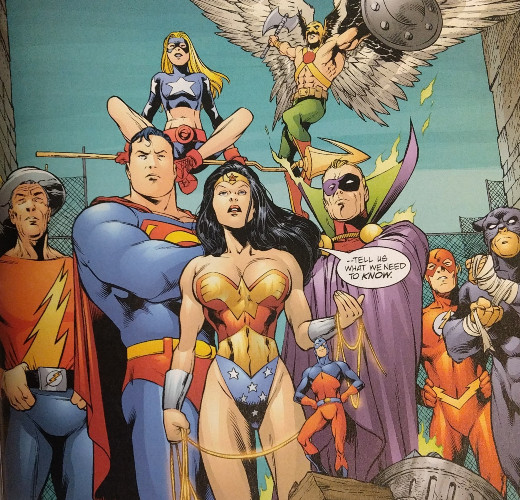
I am not terribly aware of the state of the DC Universe circa the first years of the 2000s. Most of what I know comes from reading about certain stories rather than reading the stories themselves, though I've tackled a few tales in my time. I headed into this one-shot aware of most of the characters on both sides of the super-team aisle, though in terms of personal histories, I was a tad more lax, specifically with the JSA. I do genuinely adore Robinson and Smith's limited series, but that's a whole separate narrative set in an alternate "Elsewords" universe, with no impact on today's proceedings.
I begin saying this to note that I was curious if my ignorance would affect my perspective of the one-shot–would I be confused about certain characters? Would histories which influenced the story frustrate me? Goyer and Johns are, admittedly, not terribly interested in holding the reader's hand through this narrative; the central conflict is centered around some older adversaries of the JLA and Captain Marvel/Shazam's long-standing adversaries the Seven Deadly Sins, and the story features one section devoted to visiting a location integral to JSA history, of which I was marginally aware. You're asked to remember tidbits of the time, such as Lex Luthor's presidency, as well as events occurring in a mid-80s JSA one-shot by Roy Thomas. The writers expect readers to have a familiarity with the characters and elements of their storied pasts, though you don't necessarily need to be an expert in each character to enjoy the narrative.
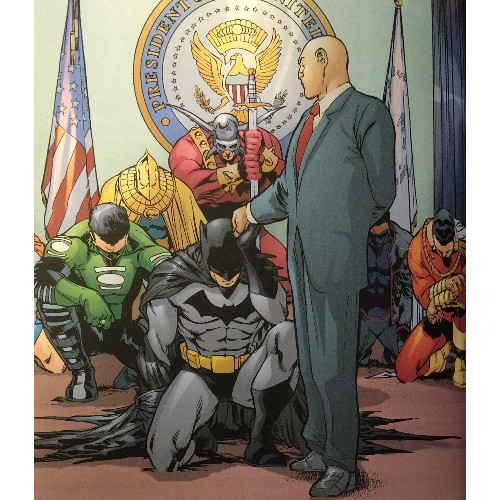
Even if histories aren't elaborated on, the reader can easily grasp various characteristics and personalities associated with our central heroes, and it's these moments which make the one-shot an engaging read. Each hero embodies ideas which are nicely shown in moments here–we see Superman's love for humanity, Stargirl's childlike awe of these heroes around her, Wally's abiding respect for Jay Garrick. You can't say any of these traits haven't been used many times in previous stories, but they note how Johns and Goyer both understand these characters. I don't know which writer was responsible for which aspects of the story–who tackled dialogue? Story? Character development? No idea–but the men seem to work well together, Johns' encyclopedic knowledge of and love for the DC Universe grafted well with Goyer's cinematic understanding of narrative. There are big, action-oriented scenes which flow well with smaller, quieter moments, creating a well-rounded tale.
(I will admit to some bias in this, though. Johns may not be my favorite comics writer, but Goyer penned the script to my favorite movie of all time, so I feel more assured of his capabilities.)
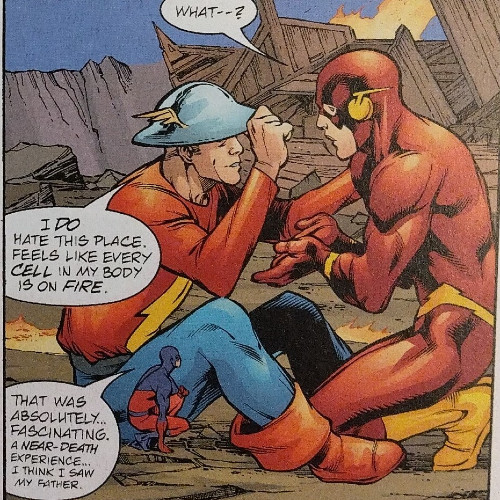
Goyer and Johns do well to allow each character relatable personality traits, largely shown through their actions…even when those actions are twisted. Kyle Rayner, possessed by Deadly Sin Envy, rails against original Green Lantern Alan Scott, decrying the older man's legacy and asserting himself as the best ring-wielder; I assume such jealousy stems from Kyle's history at trying to live up to the legacies of other Lanterns such as Scott and Hal Jordan. Batman being embraced by the Sin of Wrath, showcased in an even heavier, more violent crackdown on criminals, or Mr. Terrific, considered one of the world's smartest men, bowing to the whim of Pride and exulting in himself just makes sense for these characters. Their darkest corners are dragged into view and extrapolated to the nth degree.
A few of these choices don't work quite as well as others. Plastic Man serving as the avatar for Greed is a mediocre choice, generated, I assume, by his former criminal lifestyle as Eel O'Brien. That's pure conjecture on my part, and if that's the case, it's a fine decision. Plastic Man feels far too goofy a character to twist in this way, and even when embodying a Deadly Sin, he's no more than a gimmick, not a terrible threat in the way he could be. Power Girl captivated by the spirit of Lust feels like the most obvious, least compelling option the writers could have selected, and Captain Marvel as Gluttony is perhaps born from his youthfulness but feels chosen because the other Sins had been assigned. These are half-baked decisions which don't have characterization factored into them as well as others.
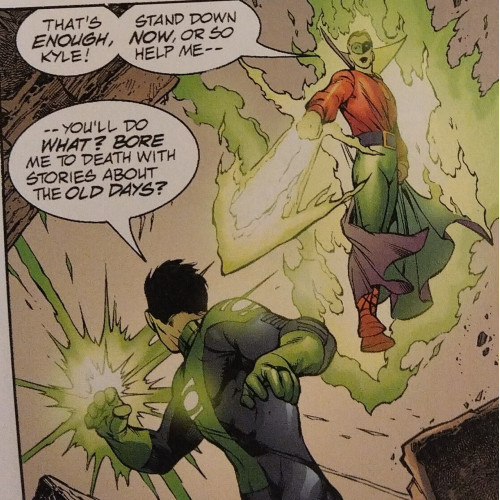
I entered the one-shot expecting more of a split between the teams, assuming we'd receive a big ole' showdown with the heroes of the past facing the heroes of the present. Skirmishes occur between individuals, but we're never given a giant take down, drag out fight, which I appreciated. Goyer and Johns do a pretty good job at preventing both teams from being siloed. They retain their corporate identities–one character defines the Society as America's greatest heroes, the League as the universe's–but there's a general feeling that neither side takes their team identity far too seriously. At the end of the day, they're heroes, one grouping just generally a little older than the other.
In, perhaps, the spirit of a story taking place around Thanksgiving, our cast is incredibly communal. You get the sense that these people work well together, admire one another (when they're not possessed by angry spirits, of course), and are willing to support one another, even when they're not facing a world-ending scenario. Some of the issue's best moments see Mr. Terrific offering Batman mashed potatoes, Superman and Alan Scott gazing lovingly at the Earth they watch over, and Wonder Woman momentarily mentoring Stargirl. The camaraderie isn't forced, feeling grounded in mutual respect between two different teams and the generations between them.

Unlike with a Thanksgiving meal, I didn't come into Virtue and Vice feeling too hungry–looking at the spread before me, I wasn't sure what to expect. As I worked through it, page by page, I found enough to appreciate, feeling fed by well-structured characters, good community between the teams, and nice touches of continuity. I didn't lean back in my chair completely stuffed by what Goyer and Johns present–no spirit of Gluttony rested upon me this time–but I was largely satisfied. Not everything tastes quite as I hoped, specifically some of the more shallow applications of the Deadly Sins, but I've never gone into a Thanksgiving dinner knowing I'll enjoy absolutely everything (cranberry sauce? No thanks). The difference between a holiday feast and a story, of course, is you get to choose what to eat at Thanksgiving; with a narrative, you've got to accept what's offered, regardless of whether you enjoy the taste, and with this one-shot, I'm glad to say it largely satisfied my emotion's taste buds.